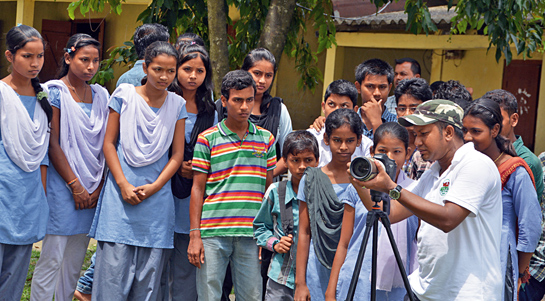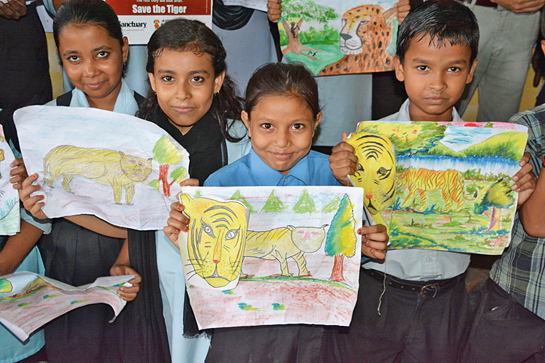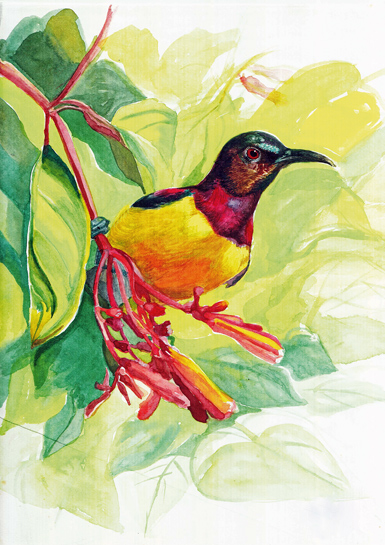WildRoots
First published in Sanctuary Asia,
Vol. 38
No. 6,
June 2018
 Photo Courtesy: WildRoots
Photo Courtesy: WildRoots
In 2016, Assam-based organisation, WildRoots, launched a programme known as Art for Conservation (AFC) in rural and urban educational institutions in the state. A brainchild of Biswajit De, the programme aims to nurture a community of artists and empower aspiring conservation artists to become effective environmental ambassadors.
Sensitising students about wildlife conservation and climate change through the medium of art was a mandate of the organisation since it was founded in 2012. The AFC programme was therefore a natural progression of the WildRoots vision to engage artists and leverage their talent for nature conservation.
De, an artist himself, says, “WildRoots imbibes the true spirit of conservation in the minds of young people. We must remember that ‘nature doesnt belong to just one person, scientist, or a community when we are trying to understand and protect it. Climate change is going to hit us hard, and its going to hit everyone irrespective of their social or economic status. Maybe we cannot save all species, which are facing extinction, but what is the harm in trying?"
Using art to convey the urgency of protecting our natural heritage, supporting art and science-based field expeditions, producing publications, organising exhibitions, workshops and fund-raising events and recognising artists are a few initiatives that WildRoots undertakes in their efforts to create environmental awareness.
Under the AFC programme, student members have recently started creating content in the form of nature-themed illustrations, essays, and poems in regional languages, which is aiding WildRoots in education outreach. Members of WildRoots have been able to distribute more than 500 publications created by them to rural and urban schools in the state. The universal appeal of their art-based approach has helped them to expand their work to the neighbouring states of Meghalaya, Nagaland and Arunachal Pradesh.
Photo Illustration: Krishna De
In 2015, WildRoots, with support of the Earth Day Network, launched a green cities campaign in Guwahati, under which the first urban butterfly garden in the city was developed by student members of WildRoots, in collaboration with some of real estate developers in the city. The organisation also strives to convince real estate developers to include green patches in what are otherwise jungles of concrete.
Assistant Secretary of WildRoots Sutirtha Lahiri says, “Conservation education is fast emerging as an important tool providing conservation values to society. At WildRoots, there is a constant and diligent effort to spread the word about our environment and wildlife - the ones we share our backyards with - amongst students from both the rural and urban areas. Its only when these children get inquisitive about their neighbourhood Blue-throated Barbet and are in awe of the Ficus fruiting in their schoolyard that we would know, that our work is done."
An organisational member of the International Union for Conservation of Natures Commission on Education and Communication and a partner of the #NatureForAll movement, WildRoots involves students in small-scale projects based on environmental and biodiversity awareness, climate change and conservation. Trained in conservation education methodologies both nationally and internationally, senior members of WildRoots engage students in activities which are coordinated with the United Nations Sustainable Development Goals.
With a belief that no matter what ones passion might be - butterflies, mushrooms, birds, reptiles, amphibians or ‘all life on Earth - there is a Citizen Science project that needs your help to thrive, the WildRoots Citizen Science Programme engages the student community in scientific research to generate information at the local level, which can be used globally by scientists and citizens alike. The organisation is also working to facilitate information and knowledge sharing between educational institutions in India and abroad.
“Citizen science, or Public Participation in Scientific Research (PPSR), has always been around, but during the last five to 10 years it has taken off with a new generation of participants, tools, Internet resources, and mobile devices. This is especially true of species inventories, which focus on counting the number of organisms found in a geographic region over a defined time period. Citizen science programmes help people connect and identify with nature. So, if you have a certain skill, you can be a part of a citizen science programme anywhere. Perhaps your involvement wont transform you into a scientist, but your contribution would enable someone do their research, or discover a new species, and most importantly, connect you with Nature. The next Attenborough or Goodall could already be part of our community, and its up to us to keep encouraging him/her!" says De, who was spotlighted at the Sanctuary Wildlife Awards in 2012.
 Photo Courtesy: WildRoots
Photo Courtesy: WildRoots
Sanctuary readers, who wish to support this NGO inspiring youth in Assam and connecting them to nature, may write to: wildroots.guwahati@gmail.com
Author: Anirudh Nair, First published in: Sanctuary Asia, Vol. XXXVIII No. 6, June 2018.


 Photo Courtesy: WildRoots
Photo Courtesy: WildRoots
 Photo Courtesy: WildRoots
Photo Courtesy: WildRoots